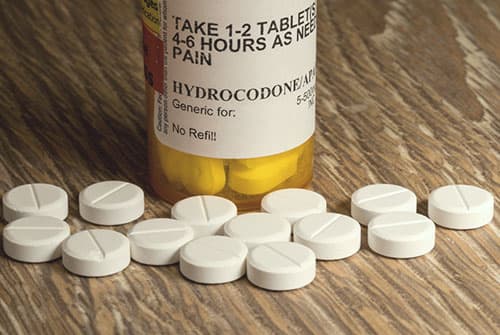SUBSTANCE ABUSE
Hydrocodone
Hydrocodone is an opioid similar to morphine that is synthesized from codeine. Unlike naturally occurring opioids such as morphine and codeine, hydrocodone is created in a laboratory. It’s typically used in the treatment of moderate to severe pain and acts as both an antitussive (cough suppressant) and an analgesic (pain reliever). It is legally prescribed in the United States as a pain medication, however, it carries a high risk of abuse and addiction.

What is Hydrocodone Used
For?
Hydrocodone was first developed in the 1920s by a German pharmaceutical company named Knoll. It was initially used as a cough suppressant and a pain reliever as it was thought to work better than codeine for coughs and as well as morphine for pain relief. Although the intention was that this drug would be less addictive than morphine and codeine, statistics show that it’s just as addictive as other opioids.
Hydrocodone is also used frequently for non-medical illicit purposes. Because it’s the most prescribed opioid in the United States, it is fairly easy to obtain. Users will obtain the drug by getting false prescriptions, stealing other peoples’ prescriptions, using prescriptions that aren’t for them, altering prescriptions, and purchasing the drug online. Hydrocodone is abused for its euphoric effects and feelings of “high” that the substance produces. It’s typically abused orally, with users often combining it with other substances.
How is Hydrocodone Used?
Hydrocodone comes in the form of extended-release (long-acting) capsules and tablets that are taken orally. The capsule is typically taken once every 12 hours and the tablet is typically taken once a day. Hydrocodone also comes in hundreds of combination medications such as Vicodin and Lortab which are made up of hydrocodone and acetaminophen.
WHAT ARE ITS BRAND NAMES?
•Hycodan
•Lorcet
•Lortab
•Norco
•Vicodine
•Vicoprofen
•Zohydro
•HYSINGLA ER
WHAT ARE ITS STREET NAMES?
•Hydros
•Lorris
•Tabls
•Vicos/Vikos
•Vics
•Watsons
HOW MANY PRESCRIPTIONS ARE WRITTEN?
Hydrocodone is the most prescribed opioid in the United States. Over the last three decades, the United States has been going through an opioid crisis. The over-prescription of opioid medication, as well as its highly addictive properties, have meant that more and more people have started to overdose and die from the misuse of opioids.
Presciption Use
In 2013, over 136.7 million prescriptions for hydrocodone and hydrocodone combination products were dispensed. In 2016, 93.7 million prescriptions were dispensed and in 2017, 83.6 million were dispensed.1 Due to the increasing efforts to combat the opioid crisis, increased awareness around the addictiveness of opioids, and stricter clinical guidelines for prescribing opioids, the rates of prescriptions dispensed has been started to go down over the years.1 This is a positive sign, however, opioid abuse is still a big problem in the U.S.
Misuse
In 2015, the National Survey on Drug Use and Health reported that a startling 7.2 million people over the age of 12 reported misusing hydrocodone. In 2016 and 2017, this number decreased to 6.9 million people and decreased again in 2018 to 5.5 million people.1 Considering that as many as 5.5 million people abuse hydrocodone alone, you can only imagine how many people are abusing other opioids and prescription medications, painting a concerning picture about the rates of opioid abuse in the U.S.1
According to the Drug Enforcement Administration (DEA), approximately 24.4 million people over the age of 12 have used hydrocodone for non-medical reasons, with a large portion of these people being teenagers.2
Effects of Hydrocodone
DRUG CLASS AND DRUG SCHEDULES
Drug Class
Hydrocodone belongs to the class of drugs known as opioids. Opioids are typically used in the treatment of moderate to severe pain, such as that experienced after surgery. Other common opioids include morphine, codeine, fentanyl, and oxycodone.
Drug Schedule
Hydrocodone is a controlled substance that is a Schedule II substance in the Controlled Substances Act.2 A Schedule II substance is one that has both a medically legitimate purpose but also carries a high potential for abuse. It also means that there are quotas on how much can be produced, restrictions on the number of prescriptions, and punishments for illegal use.2
When hydrocodone is combined with other medications such as acetaminophen or ibuprofen, it is considered to be a Schedule III substance.2 A schedule III substance has a legitimate medical purpose and carries a moderate to low risk of abuse. In other words, pure hydrocodone is considered to be riskier in terms of developing a dependence on the substance.
Effects of Hydrocodone
Hydrocodone can have both short term and long term negative effects on your health. Understanding what to look for is vital and an easy way to tell if you might have a problem with abuse.
Short Term Effects
When using hydrocodone, there is a risk that you might experience the following side effects:
•Back pain
•Constipation
•Constricted pupils
•Drowsiness
•Dry mouth
•Feelings of euphoria
•Headache
•Itchiness
•Muscle tightening
•Nausea
•Rashes
•Seizures
•Slowed breathing
•Stomach pain
•Swelling in the face/throat/foot/leg/ankle
•Trouble falling/staying asleep
•Vomiting
Is Hydrocodone Addictive?
Hydrocodone is considered to be highly addictive. This is for a couple of reasons. Firstly, it can make you experience the following feelings:
•Euphoria
•Increased sense of well-being
•Numbness of physical and emotional pain
•Relaxed and free of stress
Some people will misuse this drug to feel positive effects, while some will use it to numb any physical or emotional pain, or to cope with stress and anxiety.
Developing Dependence
Addiction develops over time, when you use the drug in excessive amounts, more frequently than normal, or for prolonged periods, your body begins to develop a physical dependence on the drug.
In other words, your body and brain learn to function with the drug in your system, therefore causing dependence on the drug. The more you take, the stronger your tolerance to the drug will be, and therefore you will need to take increasingly higher doses to feel the same desired effects. This will most likely result in dependence and addiction, and if you were to stop taking the drug, you would experience withdrawal symptoms.
What are the Signs of Addiction?
The Diagnostic and Statistical Manual of Mental Disorders outlines diagnostic criteria for substance use disorders. Signs that you or someone you know might be struggling with addiction are:
•Taking higher doses than intended
•Taking the drug for longer than intended
•Spending a lot of time obtaining and using the drug
•Having strong cravings
•Failing to fulfill responsibilities at work, home, or school
•Continuing to use the drug despite problems with relationships
•Not attending or giving up social activities or hobbies
•Putting yourself in dangerous situations to get the drug
•Using the drug even when it has negatively impacted your physical or mental health
•Needing to use more of the drug to feel the same effects
•Developing withdrawal symptoms when not using the drugs
•Taking the drug in methods other than prescribed
How Can You Stop Using Hydrocodone Safely?
The safest way to stop the use of hydrocodone is through medical detox. A medical detox program will help you to stop the drug use safely and comfortably. Typically, your vital signs will be monitored, and medications may be used to help alleviate withdrawal symptoms and prevent relapse. Medications will help to decrease cravings while lowering your tolerance. Medical detox can occur at inpatient or outpatient programs and will be tailored to each individual.
Hydrocodone Withdrawal
Depending on how long you have been taking hydrocodone and the dosage that you have been taking, you may experience withdrawal symptoms when you stop taking the substance. Typically, the withdrawal will begin between 6-12 hours after taking your last dose. Withdrawal symptoms usually peak within 72 hours and can last from between a week to a few months. For people who abuse hydrocodone and take it in excess amounts, withdrawal symptoms will usually be more severe. The best way to avoid withdrawal symptoms is to gradually taper off of drug use, as instructed by your physician.
Withdrawal Symptoms
When you have taken hydrocodone for a prolonged period of time, suddenly stopping taking the drug can cause you to experience withdrawal symptoms. Withdrawal symptoms occur when your body has developed tolerance and dependence. When your body learns to function with hydrocodone in your system, stopping its use will cause your body to react to its absence, producing withdrawal symptoms.
Withdrawal symptoms include:
•Anxiety
•Chills
•Diarrhea
•Fast heartbeat
•Irritability
•Loss of appetite
•Muscle aches
•Nausea
•Restlessness
•Runny nose
•Sweating
•Teary eyes
•Trouble sleeping
•Vomiting
•Widened pupils
Treatment Options for Hydrocodone Addiction
The safest way to stop the use of hydrocodone is to gradually lower the dose that you are taking. This should be done following your doctor’s instructions. If you are taking the drug illicitly, consider seeking out a medical detox to stop the use, or at the very least, lower the dose that you are taking gradually over the span of a few weeks or months, depending on how high the dosage you have been taking is.
Treatment options for substance use disorder typically involve some form of counseling or therapy and medication-assisted therapy.
Medication
Medications that might be used in the treatment of hydrocodone addiction are buprenorphine, naloxone, methadone and naltrexone.4
Naloxone can help to reverse the effects of an overdose and can also be used in combination with other drugs such as buprenorphine during the treatment process to help alleviate withdrawal symptoms. Buprenorphine, methadone, and naltrexone all work to reduce cravings and withdrawal symptoms and to reduce to risk of relapse. These medications ‘replace’ hydrocodone in a sense, to help users adjust to the absence of hydrocodone.
Therapy
In addition to medication-assisted therapy, a major component of substance abuse disorder treatment is counseling, therapy, or peer support groups Counseling can occur in an inpatient facility or an outpatient facility.
To overcome substance use disorder, it is important to tackle the underlying reasons that started your substance abuse. Counseling and therapy will help to identify patterns surrounding use, problematic behaviors, and ways to improve on healthy habits and creating a healthier lifestyle. Treatment programs that include counseling will help patients to:
•Learn relapse prevention skills, healthy boundaries, and communication skills
•Engage in alternative recreational activities
•Adopt skills that help to rebuild and maintain relationships
•Receive education surrounding substance abuse disorders
•Develop coping skills
•Address any co-occurring disorders or mental illnesses
Peer Support
Peer support groups such as Narcotics Anonymous also exist for people who struggle with substance use disorders and are looking to connect with other people who are experiencing the same thing. While peer support groups are not medical treatments, they help people to not feel alone in their experience and to help keep them accountable in their treatment.
The treatment of substance use disorders must address the whole person, their physical and mental health. Substance use disorder is often linked to various other aspects of a person, their personality, their mental health, their physical health, their personality traits, their relationships, and more. It is also very important to have the support of family and friends as recovery can be a long and hard journey, and it is essential to have a strong support group.

